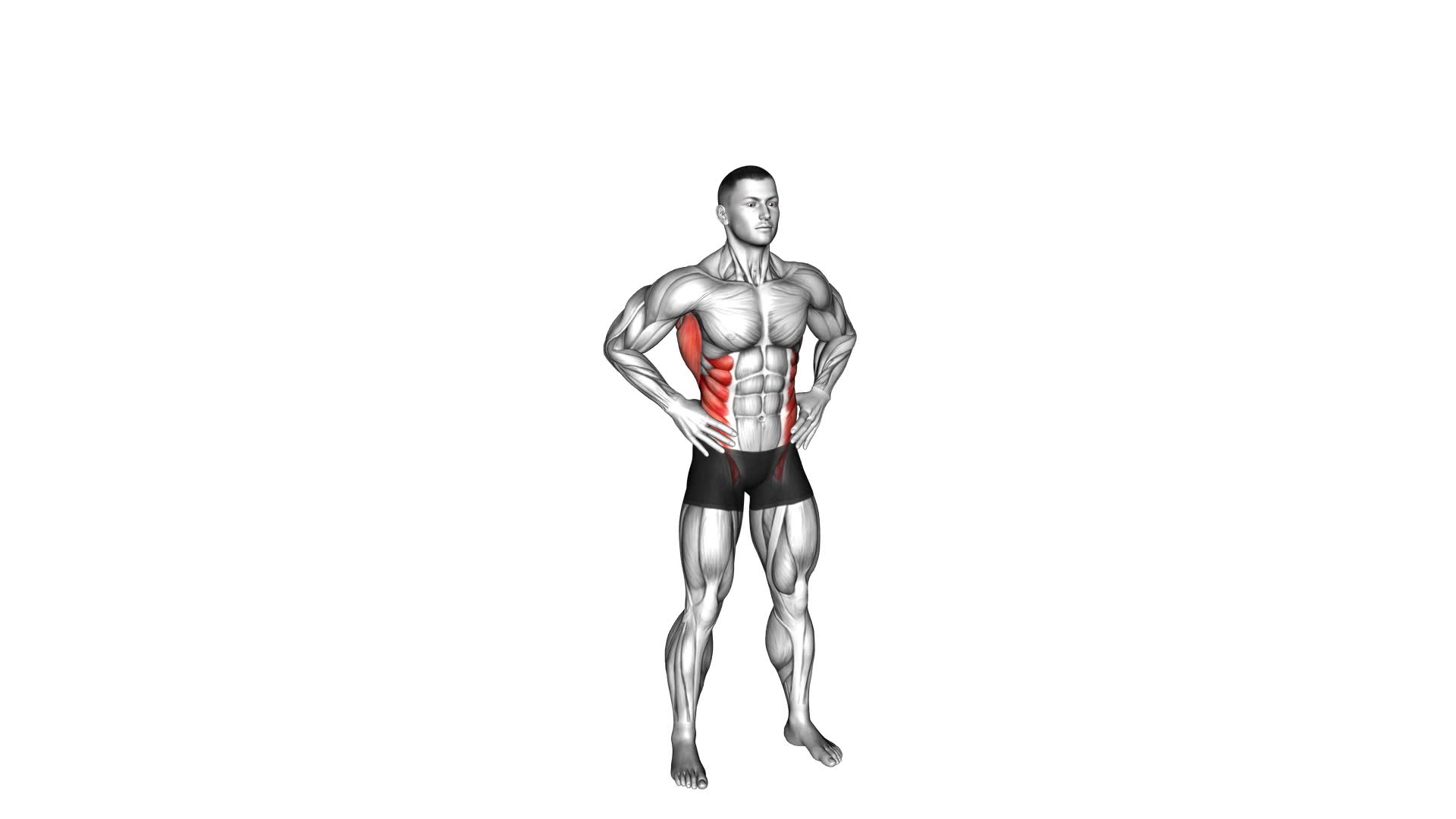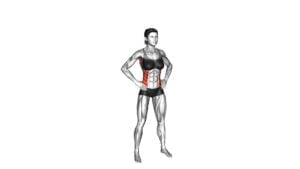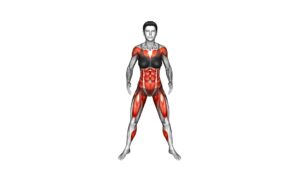Standing Behind Sky Reach (male) – Video Exercise Guide & Tips

Are you ready to take your workout to new heights? Look no further than Standing Behind Sky Reach.
Watch This Exercise Video
This video exercise guide is designed specifically for men, providing you with expert tips and techniques to maximize your results.
Whether you're a beginner or an advanced fitness enthusiast, this routine offers modifications and variations to suit your level.
Get ready to challenge yourself and elevate your fitness game with Standing Behind Sky Reach.
Key Takeaways
- Standing Behind Sky Reach improves balance, core strength, coordination, and flexibility.
- Proper form and technique are essential to avoid common mistakes and engage the targeted muscles effectively.
- Beginners can modify the exercise by reducing the range of motion and using lighter weights.
- Advanced variations of Standing Behind Sky Reach, such as single-leg, weighted, elevated, and rotational, can provide additional challenges.
Benefits of Standing Behind Sky Reach
There are 5 key benefits you can experience by incorporating Standing Behind Sky Reach into your exercise routine. This exercise is highly effective for improving balance and increasing core strength.
Firstly, Standing Behind Sky Reach focuses on improving balance. By challenging your stability, it helps to strengthen the muscles responsible for maintaining equilibrium. This can be particularly beneficial for older adults or individuals recovering from injuries, as it can reduce the risk of falls and improve overall stability.
Secondly, this exercise is great for increasing core strength. As you reach your arms overhead and lean forward, your core muscles are engaged to maintain proper posture and stability. This helps to strengthen the muscles in your abdomen, lower back, and pelvis, improving overall core strength and stability.
Incorporating Standing Behind Sky Reach into your routine can also enhance your overall coordination. This exercise requires you to coordinate movements between your upper and lower body, promoting better mind-muscle connection and overall coordination skills.
Furthermore, Standing Behind Sky Reach helps to improve flexibility in your shoulders, chest, and upper back. As you reach your arms overhead, you're stretching these muscles, promoting better range of motion and reducing the risk of muscle imbalances and injuries.
Lastly, this exercise can also contribute to better posture. By engaging your core and strengthening the muscles responsible for maintaining proper alignment, Standing Behind Sky Reach can help you develop better posture habits, reducing the strain on your spine and promoting better overall posture.
Incorporating Standing Behind Sky Reach into your exercise routine can provide numerous benefits, including improved balance, increased core strength, enhanced coordination, better flexibility, and improved posture.
Proper Form and Technique
To perform Standing Behind Sky Reach with proper form and technique, you should focus on maintaining a stable and balanced position while reaching your arms overhead and leaning forward. This exercise primarily targets your shoulders, upper back, and core muscles.
To ensure you're performing this exercise correctly, here are some tips to keep in mind:
- Common mistakes to avoid:
- Arching your back excessively: Keep your core engaged and maintain a neutral spine throughout the movement.
- Using momentum: Avoid swinging your arms or relying on momentum to lift them overhead. Focus on controlled movements.
- Hunching your shoulders: Keep your shoulders down and relaxed, away from your ears, to prevent unnecessary strain.
- Leaning too far forward: Maintain a slight forward lean but avoid excessive bending at the waist, which can strain your lower back.
- Muscle engagement:
- Shoulders: As you reach your arms overhead, focus on engaging your shoulder muscles to lift and control the movement.
- Upper back: Squeeze your shoulder blades together as you extend your arms, engaging your upper back muscles.
- Core: Throughout the exercise, engage your core muscles to maintain stability and support your spine.
Modifications for Beginners
If you're a beginner, try modifying the Standing Behind Sky Reach exercise to suit your fitness level. It's important to start slowly and focus on proper form to prevent injury and build a solid foundation.
One modification you can make is to reduce the range of motion. Instead of reaching all the way overhead, start by reaching halfway and gradually increase your range as you get more comfortable. Another modification is to use lighter weights or no weights at all. This will allow you to focus on mastering the movement without putting too much strain on your muscles.
When performing the exercise, beginners often make some common mistakes. One of the most common mistakes is arching the back or hunching the shoulders. Make sure to maintain a neutral spine and keep your shoulders relaxed throughout the movement. Another mistake is rushing through the exercise. Take your time and focus on controlled, deliberate movements to get the most out of the exercise.
Advanced Variations to Challenge Yourself
To challenge yourself further, try incorporating advanced variations of the Standing Behind Sky Reach exercise. These advanced modifications will help you push your limits and continue to build strength and flexibility. Here are some alternative exercises that you can try:
- Single-leg Standing Behind Sky Reach: Instead of using both legs, lift one leg off the ground and perform the exercise. This will increase the difficulty and engage your core muscles even more.
- Weighted Standing Behind Sky Reach: Hold a dumbbell or kettlebell in one hand while performing the exercise. The added weight will challenge your muscles and help you build more strength.
- Elevated Standing Behind Sky Reach: Place your back foot on an elevated surface such as a step or bench. This will increase the range of motion and intensify the exercise.
- Rotational Standing Behind Sky Reach: As you reach your arm up, rotate your torso to the side. This will engage your oblique muscles and improve your rotational strength.
These advanced variations will take your Standing Behind Sky Reach exercise to the next level. Incorporate them into your workout routine to continue challenging yourself and achieving new levels of fitness.
Tips for Incorporating Standing Behind Sky Reach Into Your Workout Routine
To effectively incorporate Standing Behind Sky Reach into your workout routine, consider these helpful tips.
First, it's important to start slowly and gradually increase the intensity as you become more comfortable with the exercise. Incorporating Sky Reach variations into your routine can help keep your workouts challenging and prevent plateaus. For example, you can try adding weights to increase resistance or performing the exercise on an unstable surface, like a balance board or Bosu ball. This will engage your core and improve stability.
Proper breathing techniques for standing behind Sky Reach are also essential. Remember to inhale as you lower your body down and exhale as you raise your arms overhead. This will help you maintain control and stability throughout the movement. Additionally, focus on maintaining proper form throughout the exercise. Keep your spine neutral, shoulders relaxed, and engage your core muscles to support your body.
Incorporating Standing Behind Sky Reach into your workout routine can improve your overall strength, flexibility, and balance. By following these tips and gradually progressing, you can effectively incorporate this exercise into your routine and reap the benefits it offers.
Frequently Asked Questions
How Many Calories Can You Burn by Doing Standing Behind Sky Reach?
Standing behind Sky Reach is a great exercise that can help you burn calories and improve your overall fitness. It targets multiple muscle groups, including your legs, glutes, and core. By incorporating standing behind Sky Reach into your workout routine, you can increase your calorie burn and enhance your strength and stability.
This exercise also offers modifications to suit different fitness levels and goals. So, whether you're a beginner or advanced, standing behind Sky Reach can be a beneficial addition to your fitness routine.
Can Standing Behind Sky Reach Help Improve Flexibility?
Yes, standing behind sky reach can help improve flexibility. By incorporating modifications and practicing this exercise regularly, you can gradually increase your range of motion and flexibility.
The benefits of standing behind sky reach extend beyond flexibility, as it also targets multiple muscle groups, improves posture, and enhances balance.
Incorporating this exercise into your routine can contribute to overall strength and mobility, making it a valuable addition to your fitness regimen.
Is It Necessary to Warm up Before Doing Standing Behind Sky Reach?
Before starting your standing behind sky reach exercise, it's crucial to warm up your body. Warming up helps prepare your muscles and joints for the movements involved in this exercise. It increases blood flow to your muscles, improves flexibility, and reduces the risk of injury.
Incorporating standing behind sky reach in your workout routine offers numerous benefits. It strengthens your upper body and core, improves posture, and increases shoulder mobility.
However, be mindful of common mistakes like hunching your back or using improper form.
Can Standing Behind Sky Reach Be Done Without Any Equipment?
Yes, you can do standing behind sky reach without any equipment.
Standing behind sky reach variations allow you to work your upper body and core muscles effectively using just your body weight.
This exercise targets your shoulders, back, and arms, helping to improve strength and posture.
Without the need for equipment, it can be easily incorporated into your workout routine anywhere and anytime.
Enjoy the benefits of standing behind sky reach without the hassle of equipment.
Are There Any Precautions or Contraindications for Doing Standing Behind Sky Reach?
Before attempting the standing behind sky reach exercise, it's important to be aware of any precautions or contraindications.
This exercise involves reaching your arms behind your back while standing, so if you have any shoulder or back injuries, it may not be suitable for you. Additionally, if you experience any pain or discomfort while performing this exercise, it's recommended to stop and consult with a healthcare professional.
Take care of your body and listen to its signals to avoid any potential injuries.
Conclusion
Incorporating Standing Behind Sky Reach into your workout routine can provide numerous benefits. This exercise helps increase flexibility, improve posture, and strengthen upper body muscles.
By maintaining proper form and technique, you can maximize the effectiveness of Standing Behind Sky Reach. It is important to remember that beginners can modify the movement to suit their fitness level. On the other hand, advanced individuals can challenge themselves with variations of this exercise.
Before starting any new exercise program, it is always advisable to consult with a fitness professional. They can provide guidance and ensure that you are performing the exercise correctly and safely.
So, start incorporating Standing Behind Sky Reach into your workouts today for a stronger and more balanced body.

Author
Years ago, the spark of my life’s passion ignited in my mind the moment I stepped into the local gym for the first time. The inaugural bead of perspiration, the initial endeavor, the very first surge of endorphins, and a sense of pride that washed over me post-workout marked the beginning of my deep-seated interest in strength sports, fitness, and sports nutrition. This very curiosity blossomed rapidly into a profound fascination, propelling me to earn a Master’s degree in Physical Education from the Academy of Physical Education in Krakow, followed by a Sports Manager diploma from the Jagiellonian University. My journey of growth led me to gain more specialized qualifications, such as being a certified personal trainer with a focus on sports dietetics, a lifeguard, and an instructor for wellness and corrective gymnastics. Theoretical knowledge paired seamlessly with practical experience, reinforcing my belief that the transformation of individuals under my guidance was also a reflection of my personal growth. This belief holds true even today. Each day, I strive to push the boundaries and explore new realms. These realms gently elevate me to greater heights. The unique combination of passion for my field and the continuous quest for growth fuels my drive to break new ground.



